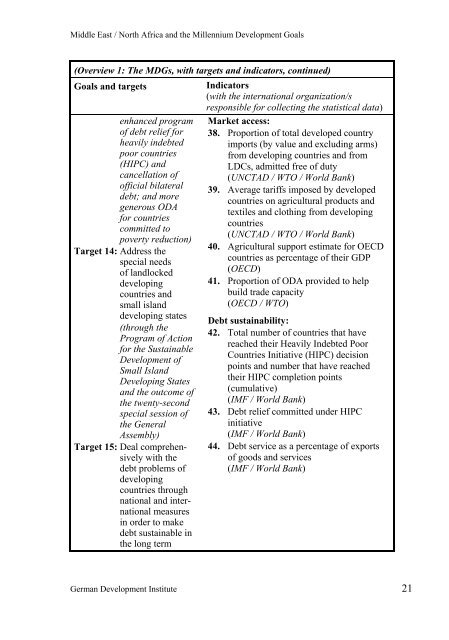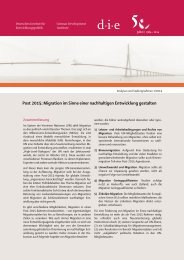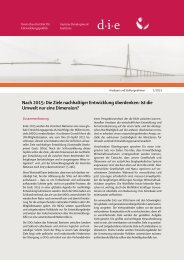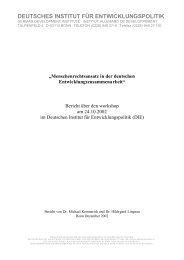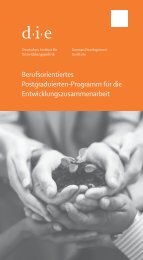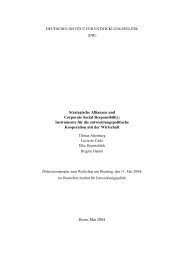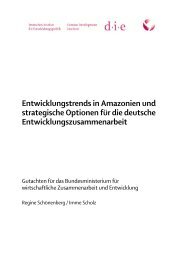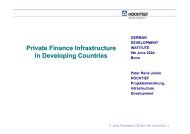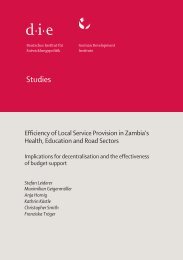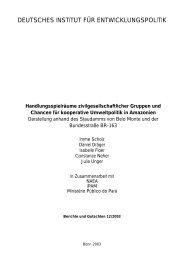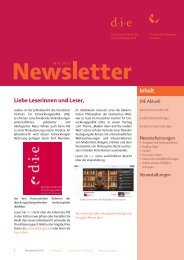Middle East / North Africa and the Millennium Development Goals ...
Middle East / North Africa and the Millennium Development Goals ...
Middle East / North Africa and the Millennium Development Goals ...
Create successful ePaper yourself
Turn your PDF publications into a flip-book with our unique Google optimized e-Paper software.
<strong>Middle</strong> <strong>East</strong> / <strong>North</strong> <strong>Africa</strong> <strong>and</strong> <strong>the</strong> <strong>Millennium</strong> <strong>Development</strong> <strong>Goals</strong><br />
(Overview 1: The MDGs, with targets <strong>and</strong> indicators, continued)<br />
<strong>Goals</strong> <strong>and</strong> targets<br />
enhanced program<br />
of debt relief for<br />
heavily indebted<br />
poor countries<br />
(HIPC) <strong>and</strong><br />
cancellation of<br />
official bilateral<br />
debt; <strong>and</strong> more<br />
generous ODA<br />
for countries<br />
committed to<br />
poverty reduction)<br />
Target 14: Address <strong>the</strong><br />
special needs<br />
of l<strong>and</strong>locked<br />
developing<br />
countries <strong>and</strong><br />
small isl<strong>and</strong><br />
developing states<br />
(through <strong>the</strong><br />
Program of Action<br />
for <strong>the</strong> Sustainable<br />
<strong>Development</strong> of<br />
Small Isl<strong>and</strong><br />
Developing States<br />
<strong>and</strong> <strong>the</strong> outcome of<br />
<strong>the</strong> twenty-second<br />
special session of<br />
<strong>the</strong> General<br />
Assembly)<br />
Target 15: Deal comprehensively<br />
with <strong>the</strong><br />
debt problems of<br />
developing<br />
countries through<br />
national <strong>and</strong> international<br />
measures<br />
in order to make<br />
debt sustainable in<br />
<strong>the</strong> long term<br />
Indicators<br />
(with <strong>the</strong> international organization/s<br />
responsible for collecting <strong>the</strong> statistical data)<br />
Market access:<br />
38. Proportion of total developed country<br />
imports (by value <strong>and</strong> excluding arms)<br />
from developing countries <strong>and</strong> from<br />
LDCs, admitted free of duty<br />
(UNCTAD / WTO / World Bank)<br />
39. Average tariffs imposed by developed<br />
countries on agricultural products <strong>and</strong><br />
textiles <strong>and</strong> clothing from developing<br />
countries<br />
(UNCTAD / WTO / World Bank)<br />
40. Agricultural support estimate for OECD<br />
countries as percentage of <strong>the</strong>ir GDP<br />
(OECD)<br />
41. Proportion of ODA provided to help<br />
build trade capacity<br />
(OECD / WTO)<br />
Debt sustainability:<br />
42. Total number of countries that have<br />
reached <strong>the</strong>ir Heavily Indebted Poor<br />
Countries Initiative (HIPC) decision<br />
points <strong>and</strong> number that have reached<br />
<strong>the</strong>ir HIPC completion points<br />
(cumulative)<br />
(IMF / World Bank)<br />
43. Debt relief committed under HIPC<br />
initiative<br />
(IMF / World Bank)<br />
44. Debt service as a percentage of exports<br />
of goods <strong>and</strong> services<br />
(IMF / World Bank)<br />
German <strong>Development</strong> Institute 21


